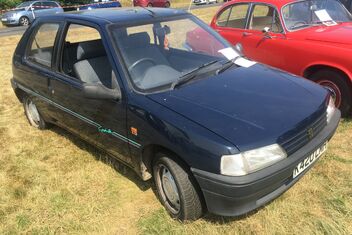
Peugeot 106
The Peugeot 106 is a city car produced by French automaker Peugeot between 1991 and 2003. Launched in September 1991, it was Peugeot's entry level offering throughout its production life, and was initially sold only as a three door hatchback, with a five door hatchback joining the range early in 1992.
For the first year of production, the 1.0 and 1.1 petrol engines came with a carburettor, but were replaced by fuel injected engines from the end of 1992, as a result of EEC emissions regulations.
Phase I[]
The "10" line of Peugeot superminis had commenced in 1972 with the launch of the 104, one of the first modern European superminis. The 104 was effectivly replaced by the 205 in 1983, but remained in production for some markets until 1988 despite the huge success of the 205.
Around the time of the 104's demise, Peugeot began developing a new entry level model to slot into its range beneath the 205 for the early 1990s.
The Peugeot 106 was introduced as a three door hatchback on 12 September 1991, when sales on the left hand drive continental markets began. It went on sale on the right hand drive market in the United Kingdom the following month. A five door version joined the range in the beginning of 1992.
The initial engine range consisted of 1.0, 1.1 and 1.4 petrol engines, as well as a 1.5 diesel. The early 1.0 and 1.1 models came with a carburettor, but were replaced with fuel injection after a year due to EC emissions requirements. It was a development of the Peugeot 205/Citroën AX platform, and was designed to slot into the Peugeot range as the new entry level model below the slightly larger 205.
It was updated early in 1996, with changes including the introduction of side impact bars and availability of driver and passenger airbags for the first time, with the new 1.6 GTI joining the range as the spiritual successor to the hugely popular and highly regarded 205 GTI, which had been discontinued in 1994.
Meanwhile, it had met the demand for a larger car by launching the 306 in the beginning of 1993; this car replaced the 309 as well as some versions of the 205, which itself lasted until 1998.
When the larger Peugeot 206 was launched in the autumn of 1998, production of the 106 was scaled back, and it was effectively repositioned as a city car, to compete with the likes of the Ford Ka and Renault Twingo, finally ceasing production after twelve years in December 2003. The 106's successor, the 107, was launched two years later as part of a venture between PSA and Toyota which also created the Citroen C1 and Toyota Aygo.
Phase II[]
In January 1996, the Peugeot 106 also formed the basis for the near identical looks and size Citroën Saxo.
Rallye version[]
Marketed as having "fewer frills, more thrills", the Rallye version did not have alloy wheels, central locking or electrically operated windows to keep the weight down to 825 kilograms.
There were pre and post facelift versions of the 106 Rallye known to enthusiasts as S1 and S2 models, with the latter having a 103bhp 1.6 litre engine instead of the high revving Rallye specific 1.3 100bhp engine fitted to pre facelift cars.
It had a five speed manual gearbox. The vehicle could be competitive in racing, but also made a practical family car. All cars had steel wheels, and Rallye decals and seat coverings featuring a three colour flash, which again varied between early and late cars.
Electric version[]
In 1995, Peugeot launched an electric powered version of the 106, called the 106 Electrique. This was offered in a number of European countries including France, Belgium, The Netherlands, Norway and the United Kingdom.
The electric powertrain was developed and built by French engineering company Heuliez. The car used Nickel-cadmium battery technology manufactured by Saft Groupe S.A., had a top speed of 56 mph (90 km/h) and had an official range of 100 km (62 mi).
Despite the high price of the vehicle, Peugeot anticipated demand for around 15,000 to 20,000 Peugeot 106 Électriques each year, with an expected total production run of 100,000 vehicles. In the end, only 6,400 Peugeot 106 Électriques were sold between 1995 and 2003, most purchased by the French Administration.
